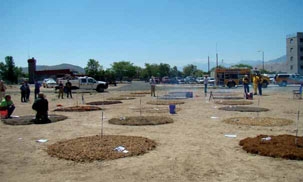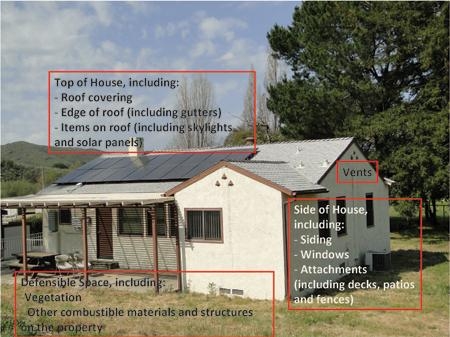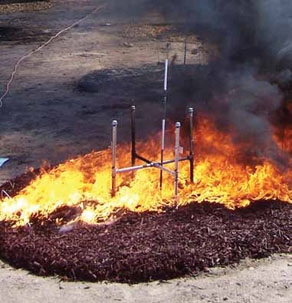Posts Tagged: mulch
Mulch the soil surface to save water in home landscapes
Mulch adds a finished, woodland-like quality to the garden, but that's not the only reason to spread organic matter on the soil surface. A layer of mulch conserves soil moisture, moderates soil temperature, and inhibits weeds, says Missy Gable, director of the UC Master Gardener Program, in the latest episode of UC Agriculture and Natural Resources' six-part home landscape water conservation video series.
Gable recommends the soil in home landscapes be covered with two to four inches of a fine- to medium-shred bark mulch. The mulch should not be applied too close to the bases of the plants so they won't be susceptible to rot.
UC Master Gardeners in Sonoma County have provided detailed information about various types of mulch, their benefits and drawbacks. For example, straw is a common, effective and inexpensive mulch. Alfalfa hay or pellets are more expensive, but because they are rich in nitrogen, give plants a nutrient boost.
Barks and hulls make an attractive, natural-looking surface. These products are often available at hardware and garden stores in bags, and in bulk at landscaping material suppliers.
Another cost-effective mulch is yard waste. Fallen leaves, grass clippings and chopped plant clippings of any kind can be spread on the soil surface to enhance and protect the soil, while reducing water evaporation.
View the video here:
View the previous videos in the UC ANR home landscape water conservation series:
Early-morning watering is best
Remove weeds from your landscape
The videos are also available on the UC ANR YouTube channel.
Coming next week, a video about using fertilizers under drought conditions.
An initiative to improve California water quality, quantity and security is part of the UC Division of Agriculture and Natural Resources Strategic Vision 2025.
Author: Jeannette Warnert
Fall
Fall is a well-named season. Downed leaves are filling rain gutters, carpeting lawns and blowing into the nooks and crannies of yards all over Solano County.
I’ve noticed something that accompanies all those leaves hitting the ground, and it’s just as annoying: leaf blowers.
(I promise this will not be a screed on blowers. They have their place in modern yard maintenance. But do we really have to fire up those blowers at 7:30 a.m. on a Saturday? And, honestly, does anyone rake anymore?)
All of this begs the question: Do we really need to clean up and haul off all those fallen leaves, only to turn around and buy bags of mulch for our yards? What’s the research-based word on using our leaves as “free” mulch? The University of California Cooperative Extension Central Coast & South Region Center for Landscape and Urban Horticulture has created a list of the pros and cons of mulch that’s very helpful. Bottom line: It does indeed pay to use your own leaves as mulch. It helps to control weeds, conserve moisture, moderate soil temperature, enhance water absorption, prevent erosion, and enrich the soil.
The key is to use only healthy leaves. Don’t toss in the mildewed grape leaves or the rust-infested rose leaves. Do consider using those pecan or walnut shells as mulch.
Another suggestion I’ve seen in the quest for successful mulching is a leaf shredder. Or, if you don’t want to go out and pay for a shredder, use your lawn mower to chop up the leaves, gather them up and spread a 2- to 4-inch layer around your plants. Remember, mulch should be used as a top dressing only. Do not mix raw mulch in with your garden soil, as it will deplete the nitrogen level in your soil as it decomposes.
My husband rakes up the leaves on our property and tosses them into compost piles. We eventually get lovely shovelfuls of leaf mold, compost that uses only leaves. Here’s a link to another UCCE article on making leaf mold, which you can use as a soil amendment or mulch.

A neighbor’s normally spotless front lawn is barely visible under a blanket of newly fallen leaves. (Photo by Kathy Thomas-Rico)
The Midsummer Garden Tune-Up
I was talking with a few fellow gardeners recently and was asked for some suggestions on what gardeners can do to keep our garden space looking its best and in the best health during the taxing, hot, summer months. The first and maybe most important thing a gardener can do in mid-summer is to mulch the beds of the garden so that moisture levels are maintained in the soil during long hot days. This will prevent some of the extra watering the garden often needs of those 90+ degree days. In addition to adding mulch I also add compost to my flower and vegetable gardens to get some fresh nutrients to the plants which are often overdue to be replenished. Most of us compost the garden in early spring and after a few months all of the beneficial nutrients have been used up and need to be replaced. It is especially important for vegetables so that they have plenty of nutrients to complete bearing mature fruit. This is also a good time to stake the larger vegetable plants for reinforcement and continued healthy production. The vegetable plants will likely increase in size after the composting has been re-done and staking the plants in advance will enable continued plant growth. The middle of summer is an opportune time to dead head old blooms and make room for fresh new ones to begin developing. It is a little detail that makes a big difference if you have lost some color in your flower garden. Finally, this time of year is a great time to weed the garden carefully, remove the unwanted weeds and make some space for your favorite plants to stretch out and fill in.
It only takes a spark
The Las Conchas fire that recently consumed nearly 137,000 acres in Los Alamos, N.M., serves as a reminder of how quickly fire can move if given fuel. I can’t light a barbecue with matches and lighter fluid, but a small ember drifting on the wind can find so many ways to burn down people’s homes if given the right conditions.
Removal of vegetation near Los Alamos National Laboratory, which is part of the UC system, created a buffer and helped spare the lab from the Las Conchas fire, which came within 50 feet. Creating a buffer is one of many preventive measures that can be taken to protect property from wildfires.
In a wildfire-prone area, even if you have a house with a concrete tile roof and noncombustible siding, an ember landing on landscape mulch, igniting plants around the home or floating into a vent on the house or under decks may set the house ablaze, warns a UC Cooperative Extension fire expert.
“From years of observing the aftermath of fires and testing fire-resistant building materials, we have developed a much better understanding about what happens,” says Steve Quarles, UC Cooperative Extension wood performance and durability advisor.
Quarles lists six priority areas for evaluating the vulnerability of homes in fire hazard zones: the roof, vents, landscape plants, windows, decking and siding. For details on how you can reduce the threat of wildfire to your home, visit Quarles' Homeowner's Wildfire Mitigation Guide.
“We know that the zone within about five feet of the home is very important to home survival during a wildfire,” Quarles says.
Landscape mulch provides many benefits to a garden, but Quarles and his colleague Ed Smith, University of Nevada Cooperative Extension natural resource specialist, found that many types of mulch are capable of catching fire and burning. Within five feet of a house, they recommend placing only rock, pavers, brick chips or well-irrigated, low-combustible plants such as lawn or flowers.
Quarles and Smith have published a new manual comparing the relative susceptibility of eight mulch treatments to igniting and burning. To download a free copy of “The Combustibility of Landscape Mulches,” visit the UC Fire Center website.

The scientists tested eight types of landscape mulches, shown in this test plot.




